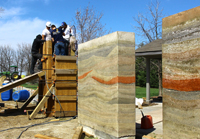Architecture students completing fifth design-build project at KU Field Station
LAWRENCE — University of Kansas third-year architecture students are wrapping up the program’s fifth design-build project at the KU Field Station. The structure, a timber canopy supported by rammed-earth walls, extends over a sunny patio at the Field Station’s Armitage Education Center, a space used by many KU groups and other visitors.
 The new structure is the latest project in an ongoing partnership between the Kansas Biological Survey, which manages the Field Station, and the School of Architecture, Design & Planning.
The new structure is the latest project in an ongoing partnership between the Kansas Biological Survey, which manages the Field Station, and the School of Architecture, Design & Planning.
“People might be surprised to know how many KU groups come to the Armitage Center for retreats and meetings,” said Scott Campbell, an aquatic ecologist and outreach director for the Biological Survey. “This structure opens the patio to more extensive use for group planning, workshops and meals. There’s more and more evidence that time spent in nature helps us think better, and this canopy means more outdoor time during these events.”
The Biological Survey asked Chad Kraus, assistant professor of architecture, and the students enrolled in the spring 2014 section of ARCH409, known as the Dirt Works Studio, to design and build a canopy.
The structure is composed of a series of five rammed-earth walls that support the 19-by-25-foot timber canopy. There are two raised timber decks, one of which serves as a speaking platform and informal seating area. The second is a viewing platform where staff and visitors may take in the setting sun.
Kraus said the students’ design was inspired by the restored tallgrass prairie area adjacent to the Armitage Center and the landscape beyond.
McKenzie Liebl, one of the class members, said: “The waving prairie grass and Kansas soil formations inspired the ribbon pattern in the surface of the rammed earth walls, as well as the undulating curves of our wood canopy. We used both the walls and the canopy as framing devices to emphasize the landscape.”
Kraus said, “The students did all the project’s design and construction work, building supporting slabs of rammed earth, and used reclaimed cedar, southern white pine and Douglas fir for the canopy. Galvanized steel connectors fabricated by the students and steel wire rope knit the structure together.”
After the structure is completed, the space will be known as the Armitage Education Center Pavilion.
The project was built on a budget of $5,000, including $3,000 in funding from the Friends of the KU Field Station and $2,000 from the architecture school. The students also received in-kind donations and discounts from several area companies: Westar Energy Inc., Monarch Cement Co., Hamm Quarry Inc., Landoll Corporation, Valmont Industries Inc. and Murray Decorative Concrete Supply Inc. The KU Facilities Services Construction and Landscape Shop lent equipment for the project, and Apex Engineers Inc. provided consultation expertise. From the Kansas Biological Survey, Bruce Johanning, Field Station operations manager, and Vaughn Salisbury, Field Station program manager and biologist, provided consultation and logistical support.
The students who designed and built the structure:
- Ragan Allen, Portland, Oregon
- Corey Boucher, Saint Peters, Missouri
- Nicholas Colbert, Overland Park
- Connor Crist, Marysville
- James DeFries, Warrensburg, Missouri
- Michael DeFries, Warrensburg, Missouri
- Matthew Everest, Mission
- Vincent Graceffa, Gardner
- Chandler Hanna, Savannah, Missouri
- Brittany Hodges, Leawood
- Andrew Kloppenburg, St. Louis
- Shira Kohn, Northbrook, Illinois
- Michael LaVanier, Shawnee
- McKenzie Liebl, Lawrence
- Chloe Lockman, Kansas City, Kansas
- Erin McFarland, Lenexa
- Jared Pechauer, St. Louis
- Ariel Peisen, Lenexa
- Taylor Pickman, Atchison
The KU Field Station’s core area north of Lawrence, which consists of 1,800 acres with five miles of public trails, is open to programs across the university as a teaching and research resource. Its best-known areas are the Fitch Natural History Reservation and the Rockefeller Native Prairie. Faculty and students in the arts, humanities and professional schools, including architecture, psychology, history, English, journalism, fine arts, exercise science and other fields, have used the Field Station for academic purposes.
The Kenneth and Katie Armitage Education Center houses laboratories and classroom space. It is situated at the KU Field Station’s core Research and Operations Center, 350 Wild Horse Road. The KU Field Station totals about 3,400 acres, devoted to scientific research, across 10 tracts in Douglas, Jefferson and Anderson counties. It is managed by the Kansas Biological Survey, which was established at KU in 1911.